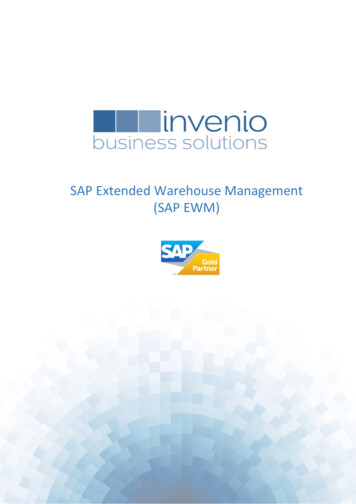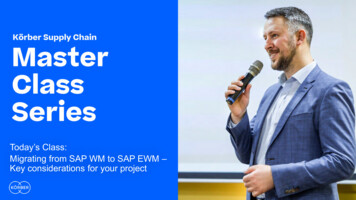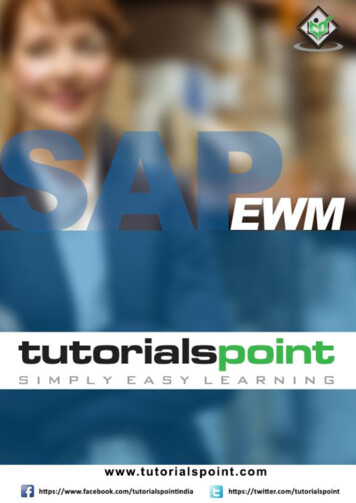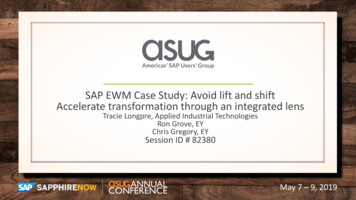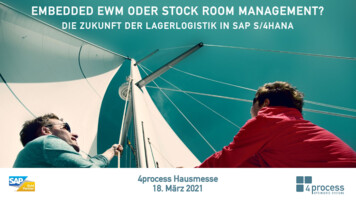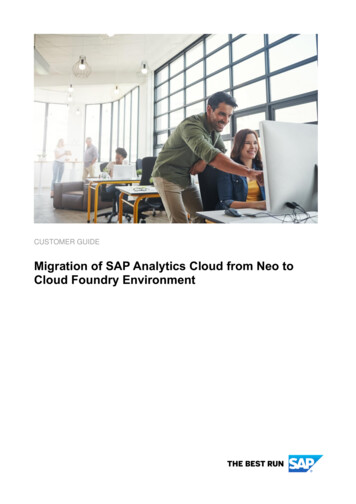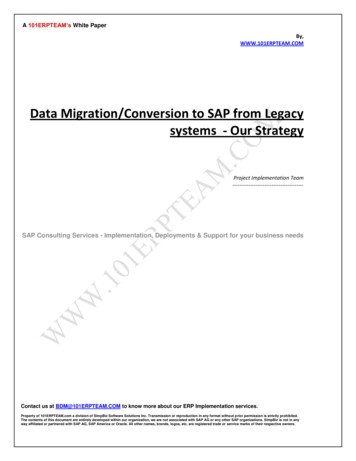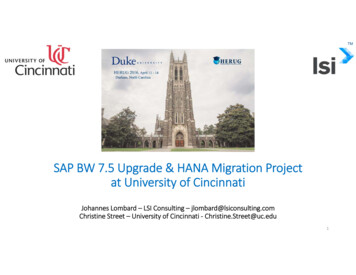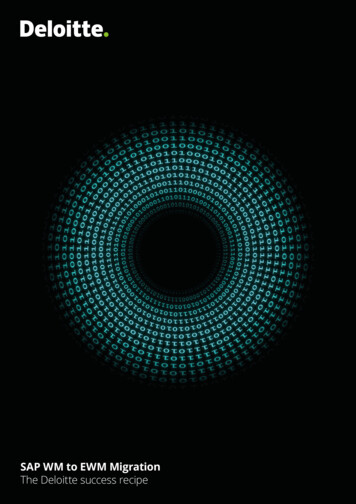
Transcription
SAP WM to EWM MigrationThe Deloitte success recipe
More than a decade ago, SAP released its new warehousing solution, ‘Extended Warehouse Management’ (EWM), whichintroduced a new set of functionalities that were missing in WM that enabled the management of far more complexwarehouse operations.Although SAP announced upon EWM’s release that it wouldn’t replace WM, but would rather be an additional solutiontailored to complex logistics execution in the supply chain, they simultaneously declared their intention to stop developingECC WM, focusing solely on developing new features for SAP EWM.Since then, multiple white papers have been published to aid companies in understanding the differences between WMand EWM, helping them identify the best fit solution. But what about companies already running on SAP WM getting moreand more convinced of the necessity to migrate to EWM? How should they approach this migration process? How much oftheir initial setup can they leverage? How would the project look like? What would be the cost of such project?The objective of this point of view is to try to bring an answer to some of those questions.EWM represents a brand new solution fromtechnical architecture point of view. SAPdecided to go for a ‘Rebuild’ approach forthe following reasons: Accommodation of high data volumerequirement Introduction of new concepts like processmanagement and many other newfunctionnalities. Avoidance of the high risk of thearchitecture change of an existing matureWM solution. Consolidation and incorporation ofthe functionalities added over time(Handling Unit Management, ResourceManagement, TRM, Yard Management )into a new all-containing foundation.From a functional architecture point of viewhowever, it is obvious that multiple coreWM objects have been transposed to thenew EWM core. To facilitate the migrationof these objects, SAP has even foreseen amigration tool built into EWM. So what canwe migrate from WM to EWM? Warehouse structureSince the warehouse structure presentssignificant similarities between EWM andWM, one can find the following objects onboth systems: Warehouse Storage Types Storage SectionHowever, some of the previous objectshave been slightly enhanced. For example,the length of the storage types and storagesections has been extended from 3 digits to4 digits. Additionally, HU management cannow be managed on the storage type level.Apart from these limited enhancements infunctionally, the functional concepts are stillidentical.Storage Bin TypesStorage BinsQuantPicking Area (renamed to Activity Area forpicking activity) Staging Areas DoorsEWM Warehouse structureWarehouse number E100Storage type: 0020Storage type: 0050Storage type: 0150Storage section: 0001Storage section: 0001Storage section: 0001Storage binsbinsStorageStorage binsbinsStorageStorage binsbinsStorage0020-01-1-01Activity area: INVE2Storage bins0050-01-1-AStorage section: 0002Storage binsStorage binsbinsStorage0150-10-01-01Activity area: Pick0150-20-01-A
Cross Processing ObjectsMany of the cross processing objects find theirancestors in WM like: Handling Units Packaging Material Types Handling Unit Types (originally called Storage UnitTypes in WM) Warehouse process types (originally called MovementTypes) Queues within Resource ManagementWarehouse Movement StrategiesAll warehouse movements have the samefunctional foundations and determinationtechniques. Putaway Strategy Stock Removal Strategy Replenishment StrategyStock and Master DataAn important part of the ECC-WM master datacould be recuperated with very few adjustments. Vendor Master Data Customer Master Data Bin Master Data Bin Sorting for picking and cross line Putaway Stock DataThe warehouse structure similarities is a keyaccelerator factor in WM to EWM migrationproject3
Migration Project approachObjects Migration and Basic SystemSetupThis phase should be considered purelyIT, consisting mainly of importing allthe objects that have been listed in theprevious section. The settings behind thesemigrated objects have been previouslydecided and approved by business duringthe initial WM implementation.SAP provides a user-friendly migration toolthat covers most of the in-scope objects.This tool is available as part of the EWMmodule and works by reading the data,through an RFC connection, from thesource WM system and downloading it intoa file that could then be uploaded to thedestination EWM system.The end of this phase will therefore consistof some basic EWM-specific configurationlinking the migrated objects to a process.This could consist of setting up the inboundand outbound documents and mappingthem to ECC-LE documents. It could alsoinclude the creation of a standard basicprocess by stream. The objective wouldbe to create a sandbox environment thatreflects as closely as possible the flows thatexisted in the source LE-WM system. Thisenvironment would then be the startingpoint for the EWM specific configuration.Considering what it would take to get to thesame level of system readiness in a classicEWM implementation, there is no doubtthat this phase leads to a significant timeand effort reduction in the overall project.EWM Specific FunctionalityImplementationOnce the WM objects are migrated toEWM and make working processes,the implementation team can start onbuilding the EWM specific functionalitysuch as process-oriented storage control,warehouse order creation rules, and wavemanagement.This phase should be conducted usingthe approach typically used in any SAPimplementation, consisting of four maincycles: Blueprint Realization Testing and Final Preparation Go-Live and SupportIt is however highly recommended tothoroughly validate the migrations results,obtained via the execution of the migrationusing this tool, by verifying and testing thefinal configuration.WM To EWM Migration: Project approachMigrationTechnical Migration4EWM Specific Functionnality ImplementationBlue PrintRealizationCut over andPreparationGo Live and support
Benefits of the migration approachThe WM-EWM migration approach hasmultiple benefits and implications onthe project timeline, and cost.Project Timeline AccelerationWe can observe this timeline acceleration atthe following phases: Blueprint phaseOn a typical EWM blueprint thereis significant time allocated to theexplanation and demonstration of EWMcore objects. Business needs to fullycomprehend the concepts in order toformulate their requirements. This isclearly where the main benefit of themigration approach resides. The business’familiarity with those core concepts willhighly improve their engagement in theproject and their ability to think along withnew possibilities within EWM.Moreover, the scope of the blueprintdiscussions would get focused on theEWM specific features such as processand layout-oriented storage control,warehouse order creation rules, and wavemanagement.Service Cost ReductionEven though there is no way around theEWM license cost today, it seems obviousthat the migration approach offers a bigopportunity to reduce the implementationservice cost.Because many of the building blocks of thefinal EWM solution will be derived from theWM source system, total implementationeffort and service cost can be reduced at allstages of the project. Build phaseWith the migration tool that has beenmade available by SAP, the configurationof the migrated objects gets reducedto simply tweaking the additionalEWM-specific options. For example, awarehouse process type will be availablewith the settings that were in place on theWM warehouse movement type.The biggest block of the configuration willthen get shifted toward setting up theEWM specific functionalities.5
Risks of the Migration ApproachWith a new approach come new risks and the mainone is related to the developments scope.It is common for mature WM systems to containmultiple enhancements and custom developmentsimproving on the standard functionality. If that isthe case, it is absolutely crucial to assess the scopeof development in EWM.Whereas some of the developments on WM couldbe covered by standard EWM functionalities, it islikely that some functionalities offered by otherdevelopments would need to be replicated in EWM.And even though SAP tried to create a certainanalogy between ECC development points (Userexists, BADI’s BAPI’s ) and the ones in EWM, thetechnical architectural differences between the twosystems will certainly pose some challenges.It is therefore highly recommended to conduct athorough development scope assessment to coverthis risk.6
Brochure / report title goes here Section title goes here ConclusionMigrating a client from WM to EWM offers multipleopportunities to propose a leaner implementationprocess with reduced scope, time, and cost. This is why itseems adequate to propose an entirely different projectapproach to clients that are already running on WM thanwe typically offer to our prospects.The success recipe of a WM-EWM Migration would bea good mixture of WM and EWM knowledge both fromfunctional and technical points of view.Deloitte’s long history of successful implementations ofWM and EWM makes it an ideal partner for any companyseeking to embark on this journey.7
ContactsFor more information, please contact:Steven MoorsLeader CoE SAP EWMPartner 32 2 749 56 98stmoors@deloitte.comSkander KammounManager 32 2 749 54 66skkammoun@deloitte.comTom PottelSenior Lead 32 2 749 56 84tpottel@deloitte.comDeloitte refers to one or more of Deloitte Touche Tohmatsu Limited, a UKprivate company limited by guarantee (“DTTL”), its network of member firms,and their related entities. DTTL and each of its member firms are legallyseparate and independent entities. DTTL (also referred to as “Deloitte Global”)does not provide services to clients. Please see www.deloitte.com/about for amore detailed description of DTTL and its member firms.Deloitte provides audit, tax and legal, consulting, and financial advisoryservices to public and private clients spanning multiple industries. With aglobally connected network of member firms in more than 150 countries,Deloitte brings world-class capabilities and high-quality service to clients,delivering the insights they need to address their most complex businesschallenges. Deloitte has in the region of 225,000 professionals, all committedto becoming the standard of excellence. November 2017 Deloitte BelgiumDesigned and produced by the Creative Studio at Deloitte, Belgium.3809This publication contains general information only, and none of DeloitteTouche Tohmatsu Limited, its member firms, or their related entities(collectively, the “Deloitte Network”) is, by means of this publication, renderingprofessional advice or services. Before making any decision or taking anyaction that may affect your finances or your business, you should consulta qualified professional adviser. No entity in the Deloitte Network shall beresponsible for any loss whatsoever sustained by any person who relies on thispublication.
EWM represents a brand new solution from technical architecture point of view. SAP decided to go for a ‘Rebuild’ approach for the following reasons: Accommodation of high data volume requirement Introduction of new concepts like process management and many other new functionnalities. Avoidance of the high risk of the
